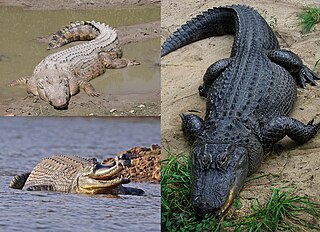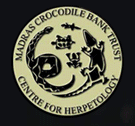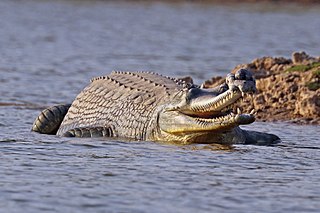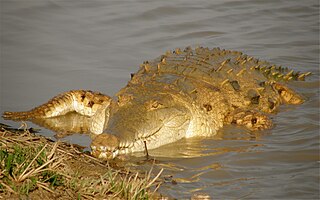Related Research Articles

Herpetology is a branch of zoology which studies amphibians and reptiles. Birds, which are cladistically included within Reptilia, are traditionally excluded here; the separate scientific study of birds is the subject of ornithology.

Crocodilia is an order of mostly large, predatory, semiaquatic reptiles known as crocodilians. They first appeared 94 million years ago in the Late Cretaceous period and are the closest living relatives of birds, as the two groups are the only known survivors of the Archosauria. Members of the order's total group, the clade Pseudosuchia, appeared about 250 million years ago in the Early Triassic period, and diversified during the Mesozoic era. The order Crocodilia includes the true crocodiles, the alligators and caimans, and the gharial and false gharial. Although the term crocodiles is sometimes used to refer to all of these, crocodilians is a less ambiguous vernacular term for members of this group.

An alligator, or colloquially gator, is a large reptile in the Crocodilia order in the genus Alligator of the family Alligatoridae. The two extant species are the American alligator and the Chinese alligator. Additionally, several extinct species of alligator are known from fossil remains. Alligators first appeared during the Oligocene epoch about 37 million years ago.

The American alligator, sometimes referred to colloquially as a gator or common alligator, is a large crocodilian reptile native to the Southeastern United States. It is one of the two extant species in the genus Alligator, and is larger than the only other living alligator species, the Chinese alligator.

The saltwater crocodile is a crocodilian native to saltwater habitats, brackish wetlands and freshwater rivers from India's east coast across Southeast Asia and the Sundaic region to northern Australia and Micronesia. It has been listed as Least Concern on the IUCN Red List since 1996. It was hunted for its skin throughout its range up to the 1970s, and is threatened by illegal killing and habitat loss. It is regarded as dangerous to humans.

The Madras Crocodile Bank Trust and Centre for Herpetology (MCBT) is a reptile zoo and herpetology research station, located 40 kilometres (25 mi) south of the city of Chennai, in state of Tamil Nadu, India. The centre is both a registered trust and a recognized zoo under the Wildlife (Protection) Act, 1972 and comes under the purview of the Central Zoo Authority, Ministry of Environment, Forest and Climate Change, Government of India. It was established with the aim of saving three Indian endangered species of crocodile—the marsh or mugger crocodile, the saltwater crocodile, and the gharial, which at the time of founding of the trust were all nearing extinction.

The Chinese alligator, also known as the Yangtze alligator, China alligator, or historically the muddy dragon, is a crocodilian endemic to China. It and the American alligator are the only living species in the genus Alligator of the family Alligatoridae. Dark gray or black in color with a fully armored body, the Chinese alligator grows to 1.5–2.1 metres (5–7 ft) in length and weighs 36–45 kilograms (80–100 lb) as an adult. It brumates in burrows in winter and is nocturnal in summer. Mating occurs in early summer, with females most commonly producing 20–30 eggs, which are smaller than those of any other crocodilian. The species is an opportunistic feeder, primarily eating fish and invertebrates. A vocal species, adults bellow during the mating season and young vocalize to communicate with their parents and other juveniles. Captive specimens have reached age 70, and wild specimens can live past 50.

The American crocodile is a species of crocodilian found in the Neotropics. It is the most widespread of the four extant species of crocodiles from the Americas, with populations present from South Florida and the coasts of Mexico to as far south as Peru and Venezuela.

The gharial, also known as gavial or fish-eating crocodile, is a crocodilian in the family Gavialidae and among the longest of all living crocodilians. Mature females are 2.6 to 4.5 m long, and males 3 to 6 m. Adult males have a distinct boss at the end of the snout, which resembles an earthenware pot known as a ghara, hence the name "gharial". The gharial is well adapted to catching fish because of its long, narrow snout and 110 sharp, interlocking teeth.

The Wildlife Conservation Society (WCS) is a 501(c)(3) non-governmental organization headquartered at the Bronx Zoo in New York City, that aims to conserve the world's largest wild places in 14 priority regions. Founded in 1895 as the New York Zoological Society (NYZS), the organization is now led by President and CEO, Monica P. Medina, who replaced long time President and CEO Cristián Samper in 2023. WCS manages four New York City wildlife parks in addition to the Bronx Zoo: the Central Park Zoo, New York Aquarium, Prospect Park Zoo and Queens Zoo. Together these parks receive 4 million visitors per year. All of the New York City facilities are accredited by the Association of Zoos and Aquariums (AZA).

The Orinoco crocodile is a critically endangered crocodile. Its population is very small, and they can only be found in the Orinoco river basin in Venezuela and Colombia. Extensively hunted for their skins in the 19th and 20th centuries, it is one of the most endangered species of crocodiles. It is a very large species of crocodilian; males have been reported up to 6.8 m in the past, weighing over 900 kg (2,000 lb), but such sizes do not exist today, 5.2 m being a more widely accepted maximum size. A large male today may attain 4.2 m in length and can weigh up to 450 kg (1,000 lb), while females are substantially smaller with the largest likely to weigh around 225 kg (496 lb). Sexual dimorphism is not as profound as in other crocodilian species. The coloration is light even in adults.
Karl Patterson Schmidt was an American herpetologist.

The West African slender-snouted crocodile, or slender-snouted crocodile, is a critically endangered species of African crocodile. It is one of five species of crocodile in Africa, the other four being the Central African slender-snouted, Nile, West African and dwarf crocodiles.

A crocodile farm or alligator farm is an establishment for breeding and raising of crocodilians in order to produce crocodile and alligator meat, leather from crocodile and alligator skin, and other goods. Many species of both alligators and crocodiles are farmed internationally. In Louisiana alone, alligator farming is a $60 to $70 million industry. Most crocodile farms are located in Thailand.
Lee Fitzgerald is Professor of Zoology and Faculty Curator of Amphibians and Reptiles in the Department of Wildlife and Fisheries Sciences at Texas A&M University. His biological specialty is the evolutionary ecology and conservation biology of amphibians and reptiles (herpetology). Fitzgerald is a former editor of Herpetological Monographs.
John L. Behler was an American naturalist, herpetologist, author, and activist known for his work in conserving endangered species of turtles, snakes, and other reptiles. He served as curator of herpetology at the Bronx Zoo, part of the Wildlife Conservation Society from 1976 to 2006. He co-chaired the IUCN Tortoise and Freshwater Turtle Specialist Group, and was a founding member of the Turtle Survival Alliance, which co-present the Behler Turtle Conservation Award with the Turtle Conservancy and Turtle Conservation Fund. The Behler Turtle Conservation Award is a major annual award to honor leadership in the field of freshwater turtle and tortoise conservation. The Turtle Conservancy named its captive breeding center, the Behler Chelonian Center, in his honor.

The Crocodile Zoo is a zoo on the Danish island of Falster. It is located northeast of Eskilstrup, towards the northern centre of the island. Established in 2000, the zoo has the world's largest collection of crocodilians with almost all existing species. Their male Nile crocodile Sobek, at more than 5 m (16.5 ft) long and 600 kg (1,300 lb) in weight, is the largest crocodilian in Europe, and Medusa, a 6.3 m (20.5 ft) reticulated python, is among the largest snakes in Europe. Although primarily focussed on crocodilians, the zoo is also home to cougar (puma), clouded leopard, tayra, callitrichid monkeys, parrots and giant tortoises.
Lee Saunders Crandall was an American ornithologist and General Curator of Bronx Zoo. He worked at the Bronx Zoo from 1908 until his death in 1969.
James Arthur Oliver was an American zoologist, herpetologist and educator who served as the Director of the American Museum of Natural History, the New York Zoological Park and the New York Aquarium.
References
- ↑ New York Zoological Society/Wildlife Conservation Society Annual Reports. 1954–1998.
{{cite journal}}: Missing or empty|title=(help) - ↑ Brazaitis, Peter (1969). "Determination of Sex in Living Crocodilians". British Journal of Herpetology. 4: 54–58.
- ↑ Thorbjarnarson, John and Xiaoming Wang. (2010). The Chinese Alligator: Ecology, Behavior, Conservation, and Culture. Baltimore: The Johns Hopkins University Press. pp. xvi. ISBN 9780801893483.
- ↑ Brazaitis, Peter; J. Abene (2008). "History of Crocodilian Science at the Bronx Zoo, Wildlife Conservation Society". Herpetological Review. 39 (2): 135–48.
- 1 2 Brazaitis, Peter (2003). You Belong in a Zoo! Tales from a Lifetime Spent with Cobras, Crocs, and Other Creatures. New York: Villard.
- ↑ Brazaitis's experience in this field is described in Ackerman, Diane (1991). The Moon by Whale Light: And Other Adventures Among Bats, Penguins, Crocodilians and Whales. New York: Random House. pp. 79–82. ISBN 978-0679742265.
- ↑ "Crocodilian Advisory Group".
- ↑ "CGS Membership". IUCN - SSC Crocodile Specialist Group. Archived from the original on 9 March 2012. Retrieved 15 March 2012.
- ↑ "Peter Brazaitis, Curatorial Affiliate". Yale Peabody Museum of Natural History. Retrieved 15 March 2012.
- ↑ McNeil, Donald G. Jr. (23 December 2003). "Peter Brazaitis; A Career Spent Studying Creatures With Spit and Venom". New York Times. Retrieved 15 March 2012.
- ↑ "Booklist Editors' Choice: Adult Books for Young Adults, 2003". Booklist.